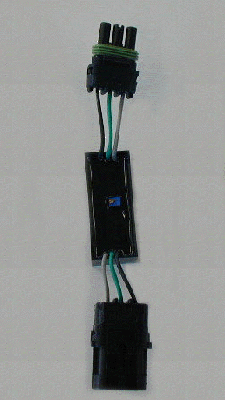TD-Max Boost Controller

The TD-Max Boost Control fits 94 to Present EFI equipped GM 6.5L Turbo Diesels. It is designed to give the user the ability to increase the maximum boost level allowed by the vehicles computer program. Installation is quickly accomplished by unplugging the vehicle harness from the boost sensor (rectangular black module) atop the intake manifold extension, and plugging the TD-Max Boost Control inline. TD-Max Boost Controls come preset to a mild level, giving you a very good starting point. Simply turn the adjusting screw in for a higher peak boost and out for less. A boost gauge IS required. Peak boost will be found at approximately 2200-2500RPM in OD with the accelerator pedal depressed as far as can be without unlocking the Torque Converter clutch or causing a downshift (auto trans. only). This device can be used in conjunction with a Performance Chip and High Flow Injectors.
A word of caution:
This device will allow boost levels higher than optimum.
For non-Intercooled vehicles, a 9-12 psi peak is the maximum recommended.
More boost can be used on Intercooled applications.
Proceed with caution.
A boost gauge is absolutely necessary to see where you are adjusting. I prefer a 15 psi gauge when working with most 6.5’s and the stock turbo. This provides the best resolution. If you feel the need to go higher, try to keep the max pressure reading on the gauge as close to the peak boost as possible for best accuracy.
In order for these devices to work there must be sufficient (25″hg) source vacuum from pump, a good vacuum line system and solenoid, as well as a leak free waste gate actuator. A free breathing exhaust system like the Kennedy 3.5″ system is also recommended. The TD-Max boost control is preset to a solid yet safe level of increase, that may be adjusted via the small multi-turn screw. Clockwise will increase boost and counter-clockwise will decrease boost. Start with 1/2 turn increments until you get close to target. It should never take more than 3-4 full turns to get where you want to be so if the boost levels are not responsive, start checking the vacuum waste gate system.
1994-5 Model years: All had dual sensors. One for baro and one for boost, and each has a different connector “keying” so they will not interchange. These trucks are best suited to a performance chip, but boost can be added via the TD-max if done properly. You can only adjust the boost sensor signal so far without doing the same on the baro sensor. This brings up the duty cycle of the waste gate and also keeps the pressure differential sufficient so that the computer does not see insufficient boost levels. The amount of adjustment that can be done will vary from truck to truck. TD-max controllers can be matched by using an ohm meter from end to end on the green wire. So long as they are set to within a few hundred ohms of each other that is fine. If SES lights are a problem, reset the controller to read approx 1.4k ohms and work up from there.
1996+ with “F” engine: All have a single sensor measuring baro and boost on same sensor. This is the best application for this device. A single TD-max will adjust the boost as high as the system is capable of going and seldom if ever sets codes. 1996+ with “S” engine: All have dual sensors. Same guidelines apply as the 94-5 except that those with the MAF sensor on the air intake (typically 97 up) are not compatible.
